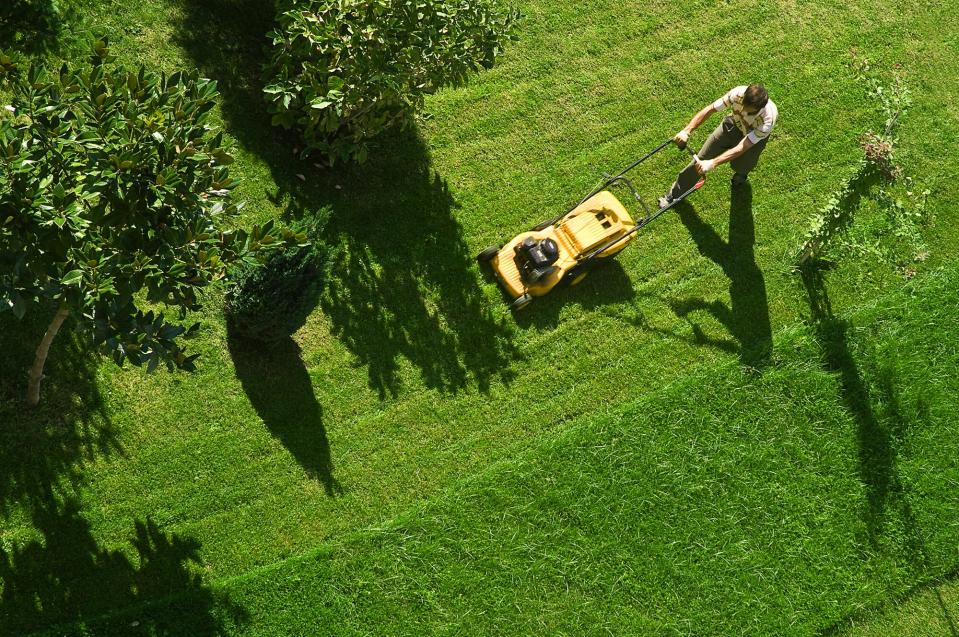How to Aerate Your Lawn—an Essential Yard Chore for Creating Lush, Thick Grass
TABLE OF CONTENTS
On This Page
What Is Aeration?
When to Aerate Your Lawn
Signs Your Lawn Needs to Be Aerated
Types of Aerators
How to Aerate Your Lawn
Aerating After Care
Maintaining a thick and healthy lawn is a dream for many homeowners. A lush carpet of green grass goes a long way when it comes to making the exterior of your property look well-manicured. While mowing and fertilizing are well-known methods that keep your landscape in tip-top shape, aeration also goes a long way. The process improves air circulation by reducing soil compaction, allowing your grass to get the nutrients it needs to grow. Although it may seem like an involved process, aerating your lawn is actually quite easy with the right tools.
Related: Our Comprehensive Seasonal Guide to Yard Cleanup

FOTOGRAFIA INC. / GETTY IMAGES
What Is Aeration?
Aeration is the process of reducing compaction within the soil. "Over time, compacted lawn soils and thatch layers can limit grass root growth and prevent air, water, and nutrients from getting to the roots," says Sadie Oldham of the natural lawn care company Instead. "Aeration creates small holes in your soil that allow water, air, and nutrients to make their way in and help the roots grow deeper and stronger." While it can be done using a few different methods, aeration typically means removing small plugs of soil from your lawn to improve airflow.
When to Aerate Your Lawn
The best time to aerate your lawn is when your grass is actively growing, so you can refill any holes with fresh plant growth. Your lawn's growing season varies depending on where you live. "Aeration is best in early fall or spring if you live in the north," says Greg Niewold, owner of Power Planter. "If you live in the south, the timing is more flexible, with the best timing during late spring or early summer."
It is also important to consider how moist the soil is prior to aerating your lawn. "To reap the benefits of lawn aeration—and make it less laborious—wait for a day or two after heavy rainfall," says Niewold. "If the ground is too wet, it'll be too muddy and messy. If it's too dry, it won't hold moisture well."
How to Know If Your Lawn Needs to Be Aerated
While most lawn care experts recommend aerating your lawn at least once a year, there is one simple way to determine whether it's necessary or not. "Take a screwdriver and penetrate the soil, and if it goes in smoothly with a small amount of resistance, then your lawn most likely does not need to be aerated," says Brent Gentling, expert builder and creator of Bring Your Own Tools. "However, if you try to penetrate the soil and it's extremely difficult with significant pressure, that means the soil is most likely very compacted and aeration is needed."
Types of Aerators
There are a few different aerating methods to choose from, with each requiring its own specific tools. While you should choose the technique that works best for you, core aerators are hands down considered the most effective method for aerating your lawn yourself.
Spike Aerators
Often designed as a rolling device that you can pull and roll around your lawn, spike aerators can poke holes into your grass without removing any soil. "Certain tools may have spike attachments that you can roll over the yard or repeatedly push around the yard," says Oldham. "There are even shoe attachments that have long spikes so you can spike while walking around the yard."
Slice Aerators
Instead of poking spikes into your lawn, you can use a slice aerator to cut through the compacted soil and thatch. "My favorite version of a slicing aerator is actually a slicing seeder, which is a walk-behind system that cuts into the soil and pushes seeds into the slices," Gentling says. "You can add many different types of seed into the machine and you basically take care of seeding and aerating all at the same time."
Core Aerators
Ask any lawn care expert and they will tell you the same—core, also known as plug aerators are the most popular way to aerate your lawn DIY-style. "Instead of pushing soil and thatch outward, it creates holes by removing cores of soil, and thatch to greatly reduce compaction issues," Oldham says. "Core aeration can be done by hand or by using powered machines."

delihayat / Getty Images
How to Aerate Your Lawn
Now that you know the most popular methods for aerating your lawn, you can begin the process. When aerating, it's important to really focus on areas of the yard you use most, because that's where the soil is most likely to be compacted.
Use irrigation flags to mark the soil where it's uneven or there are hidden stumps and roots to prevent injuries.
Rake the surface of your lawn to remove any debris, so you can see the surface of your yard.
Poke hollow prongs into the ground to remove long, narrow soil plugs with an aerator.
Remove plugs 2 to 3 inches apart to allow for more water, oxygen, and nitrogen to get to the roots.
Run the aerator over your lawn in one direction, then go back over it in a perpendicular direction.
Let the soil plugs decompose on your lawn, which will allow organic matter back into your soil.
What to Do After Aerating Your Lawn
There are a few extra steps you can take after aerating your lawn in order to reap the full benefits of the process.
Overseed the Grass
Lay down grass seed to encourage more lawn growth. "Place seeds directly in the holes from plugs for maximum growth," says Niewold. "The best grass for overseeding depends where you live—Bermuda grass or zoysia grass are great options if you live in warmer zones, and Kentucky bluegrass or tall fescue are great for cooler climates."
Fertilize the Lawn
The final step to successful aeration is following it up with fertilizer, which will ensure the turf grows thick and lush. "The thicker your lawn, the fewer weeds you'll have," says Niewold.

